Foot Conditions - Disorders and Treatments
By Isaac Tabari
There are more than 300 types of foot ailments that may occur anytime during our lifetimes. Dr. Isaac Tabari specializes in foot medicine and diabetic foot care, beginning with infancy. Babies can experience ingrown toenails and overlapping toes, children can have foot warts and heel pain when growing, and adults should have annual checkups for ingrown toenails, foot bunions and general wear and tear on their feet.
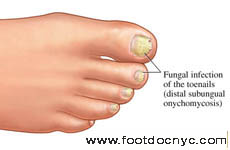 A fungus is an organism that lives in warm moist areas. Fungus of the toenails is a common problem that can affect people of all ages. Toenail fungus often beings as an infection in the skin called tinea pedis (also known as athlete's foot). The fungus often starts under the nail fold at the end of the nail. Over time it grows underneath the nail and causes changes to its appearance, such as a yellow or brownish discoloration. It can also cause thickening and deformity of the toenaill. If you are healthy, a fungal nail infection probably won't cause serious complications, but it may look bad, hurt, or damage your nail or nail bed. A fungal nail infection could lead to more serious problems if you have diabetes or a weak immune system. Make an appointment with a NYC Podiatrist about the best way to treat a nail infection if you have one of these problems. A fungus is an organism that lives in warm moist areas. Fungus of the toenails is a common problem that can affect people of all ages. Toenail fungus often beings as an infection in the skin called tinea pedis (also known as athlete's foot). The fungus often starts under the nail fold at the end of the nail. Over time it grows underneath the nail and causes changes to its appearance, such as a yellow or brownish discoloration. It can also cause thickening and deformity of the toenaill. If you are healthy, a fungal nail infection probably won't cause serious complications, but it may look bad, hurt, or damage your nail or nail bed. A fungal nail infection could lead to more serious problems if you have diabetes or a weak immune system. Make an appointment with a NYC Podiatrist about the best way to treat a nail infection if you have one of these problems.
Symptoms
A nail with a fungal infection may turn yellow or white, get thicker, crumble and split, or it may separate from the skin. When you have a fungal nail infection, it may be uncomfortable or even painful to wear shoes, walk, or stand for a long time. The fungus could also spread to other nails on your skin. Over time, the infection can cause permanent damage to your nail or nail bed.

iCorns and calluses are annoying and at times painful building of thick skin on the areas of feet where there's excess pressure. Excess pressure could be caused by improper-fitted shoes, abnormal bone shapes, or may have genetic hereditary causes. Corns and calluses can be prevented by reducing or eliminating the circumstances that lead to increased pressure at specific points on the hands and feet.
Podiatrists use various methods to treat corns and calluses such as medications, prescribing proper footware, debridement, chemically paring down of the thickened, dead skin, and at last resort, minor surgery.. Make an appointment with a NYC Podiatrist about the best way to treat corns and calluses.
Symptoms
The area may be dry and may appear to be scaly or flaky. Corns and calluses can sometimes cause pain or discomfort if they interfere with walking or other activity, but they are typically painless.

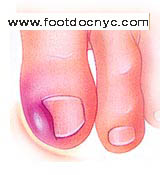 An ingrown toenail is the result of the nail growing and piercing into the skin that's adjacent to it. This commonly occurs at either edge of the big toe. Ingrown nails may be caused by improper nail trimming, inherited nail deformities such as congenitally curved nails, toe injuries, fungal nail infections, or pressure. Make an appointment with your NYC Podiatrist to discuss various ingrown nail treatment options. An ingrown toenail is the result of the nail growing and piercing into the skin that's adjacent to it. This commonly occurs at either edge of the big toe. Ingrown nails may be caused by improper nail trimming, inherited nail deformities such as congenitally curved nails, toe injuries, fungal nail infections, or pressure. Make an appointment with your NYC Podiatrist to discuss various ingrown nail treatment options.
Symptoms
Ingrown nails may cause pain at the tip of the toe or all the way to the base of the toe. The pain is often worse while walking. An ingrown nail may also cause inflammation and infection. If the toe is infected, you might see pus or redness.

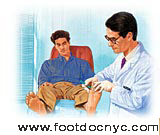 A plantar wart is an infection caused by HPV virus, which can invade your skin through small cuts or breaks. Over time, the wart develops into a hard, rough growth on the surface of the skin. A wart is most commonly seen on the bottom of the foot (plantar wart), but can also appear on the top. Children, teens, and people with allergies or weakened immune systems are more vulnerable to the wart virus. Make an appointment with a NYC Podiatrist to inquire about plantar warts destruction. A plantar wart is an infection caused by HPV virus, which can invade your skin through small cuts or breaks. Over time, the wart develops into a hard, rough growth on the surface of the skin. A wart is most commonly seen on the bottom of the foot (plantar wart), but can also appear on the top. Children, teens, and people with allergies or weakened immune systems are more vulnerable to the wart virus. Make an appointment with a NYC Podiatrist to inquire about plantar warts destruction.
Symptoms
Warts may appear spongy, with tiny red, brown, or black spots. They can grow up to an inch or more across, occurring alone (solitary) or with smaller warts clustered nearby (mosaic). Warts are sometimes mistaken for corns or calluses. They can persist for years and recur in the same spot. If left untreated, warts can spread to other parts of the foot or even to the hands or other areas of the body.

ANKLE SPRAINS
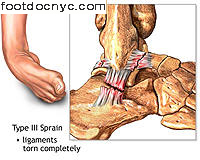 Ankle sprains are the most common musculosceletal injuries seen by podiatrists. According to statistics, more than 20,000 people each day sprain their ankles. Ankle sprains can occur at anytime, whether its during sports or dance activity, or during regular daily activity, such as stepping your foot out of the car. Planting the foot wrong on the floor / ground can cause the ankle to roll to the side. This can stretch or tear ligaments. Once you've had an ankle sprain, you may be more likely to sprain that ankle again. Make an appointment with a NYC Podiatrist about treatment for your ankle sprain. Ankle sprains are the most common musculosceletal injuries seen by podiatrists. According to statistics, more than 20,000 people each day sprain their ankles. Ankle sprains can occur at anytime, whether its during sports or dance activity, or during regular daily activity, such as stepping your foot out of the car. Planting the foot wrong on the floor / ground can cause the ankle to roll to the side. This can stretch or tear ligaments. Once you've had an ankle sprain, you may be more likely to sprain that ankle again. Make an appointment with a NYC Podiatrist about treatment for your ankle sprain.
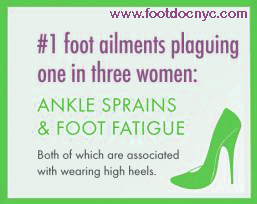 Ankle Sprain Symptoms Ankle Sprain Symptoms
Your symptoms depend on how badly the ligaments are damaged. You may have little pain and swelling if the ligaments are only stretched. If the ligaments tear, you will have more pain and swelling. The more severe the sprain, the less you'll be able to move the ankle or put weight on it. Swelling, pain, redness and warmth are all symptoms of an ankle sprain. The ankle may also look bruised, and the bruising may extend into the foot or leg.

BUNIONS / HALLUX VALGUS
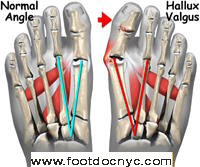 A bunion is a deformity of the foot where the big toe turns toward the outside of the foot. Also, a bump forms on the inside of the foot where the big toe begins. This is caused from improper alignment of the bones in the foot with the ankle and leg as you walk. It is a genetic, developmental problem that usually begins at an early age. Make an appointment with a NYC Podiatrist about conservative and surgical treatments for bunions and hallux valgus. A bunion is a deformity of the foot where the big toe turns toward the outside of the foot. Also, a bump forms on the inside of the foot where the big toe begins. This is caused from improper alignment of the bones in the foot with the ankle and leg as you walk. It is a genetic, developmental problem that usually begins at an early age. Make an appointment with a NYC Podiatrist about conservative and surgical treatments for bunions and hallux valgus.
Symptoms
A bunion often causes pain and swelling around the joint at the base of the big toe. The skin may become red or warm. If the big toe pushes under the second toe, a painful corn may form on the top of the second toe. In some cases, bunions cause no symptoms other than making the foot harder to fit in a shoe.

TAILOR'S BUNIONS / BUNIONETTE
Tailor's bunion, also called a bunionette, is an enlargement of the fifth metatarsal bone at the base of the little toe. The metatarsals are the five long bones of the foot. The enlargement that characterizes a tailor's bunion occurs at the metatarsal "head", located at the far end of the bone where it meets the toe. Tailor's bunions are not as common as bunions, which occur on the inside of the foot, but they are similar in symptoms and causes. Make an appointment with a NYC Podiatrist about conservative and surgical treatments for tailor's bunions.
Symptoms
Tailor's bunions often cause redness, pain and swelling at the site of the enlargement. These symptoms occur when wearing shoes that rub against the enlargement, irritating the soft tissues underneath the skin and producing inflammation. Why do we call it "tailor's bunion"? The deformity received its name centuries ago, when tailors sat cross-legged all day with the outside edge of their feet rubbing on the ground. This constant rubbing led to a painful bump at the base of the little toe.

HEEL PAIN
 Wearing shoes with poor support and no cushioning can irritate the tissue in the foot known as the plantar fascia. Being overweight or standing for long periods of time can also irritate this tissue. Any sport or activity that puts stress on the foot can cause tears in the plantar fascia and even fractures in the heel bone. Make an appointment with a NYC Podiatrist to inquire about treatments for heel pain. Wearing shoes with poor support and no cushioning can irritate the tissue in the foot known as the plantar fascia. Being overweight or standing for long periods of time can also irritate this tissue. Any sport or activity that puts stress on the foot can cause tears in the plantar fascia and even fractures in the heel bone. Make an appointment with a NYC Podiatrist to inquire about treatments for heel pain.
Symptoms
You may feel pain on the bottom or on the inside edge of your heel. The pain may be sharp when you get out of bed or when you stand up after sitting for a while. You may feel a dull ache in your heel after you've been standing for a long time on a hard surface. Running can also cause a dull ache. If a nerve is irritated, you may feel burning or a shooting pain in your heel.

METATARSALGIA
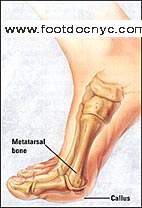 Metatarsalgia is often caused by wearing shoes with thin soles and high heels. This puts extra pressure on the bones in the ball of the foot. Standing or walking on a hard surface for long periods also puts added pressure on the bones, causing pain. The pain can occur under any of the five metatarsal bones. Bent or twisted toes and bunions can make the problem worse. So can being overweight. Sometimes high arches or arthritis can also cause metatarsalgia. Make an appointment with a NYC Podiatrist to talk about treating your metatarsalgia. Metatarsalgia is often caused by wearing shoes with thin soles and high heels. This puts extra pressure on the bones in the ball of the foot. Standing or walking on a hard surface for long periods also puts added pressure on the bones, causing pain. The pain can occur under any of the five metatarsal bones. Bent or twisted toes and bunions can make the problem worse. So can being overweight. Sometimes high arches or arthritis can also cause metatarsalgia. Make an appointment with a NYC Podiatrist to talk about treating your metatarsalgia.
Symptoms
The most common symptom of metatarsalgia is pain in the ball of the foot. it may feel as if you have a stone in your shoe. The ball of the foot may also become red and inflamed, and a callus may form under the end of the metatarsal bone.

NEUROMA
 Wearing tight or high-heeled shoes can cause a neuroma. Shoes that are too narrow or too pointed squeeze the bones in the ball of the foot. Shoes with high heels put extra pressure on the ends of the bones. When the bones are squeezed together, they pinch the nerve that runs between them. Make an appointment with a NYC Podiatrist to discuss neuroma treatments. Wearing tight or high-heeled shoes can cause a neuroma. Shoes that are too narrow or too pointed squeeze the bones in the ball of the foot. Shoes with high heels put extra pressure on the ends of the bones. When the bones are squeezed together, they pinch the nerve that runs between them. Make an appointment with a NYC Podiatrist to discuss neuroma treatments.
Symptoms
The most common symptom of a neuroma is pain in the ball of the foot between two toes. The pain may be dull or sharp. It may feel as if you have a stone in your shoe. You may also have tingling or numbness in one or both of the toes. Symptoms may occur after you have been walking or standing for awhile. Taking off your shoes and rubbing the ball of your foot may relieve the pain.

PLANTAR FASCIA
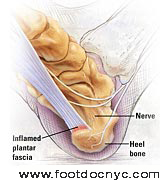 The
plantar fascia is a ligament-like band running from your heel to the ball of
your foot. This band pulls on the heel bone, raising the arch of your foot as it
pushes off the ground. But if your foot moves incorrectly, the plantar fascia
may become strained. The fascia may swell and its tiny fibers may begin to fray,
causing plantar fasciitis. This can also be the beginning of a heel spur.
Make an appointment with a NYC Podiatrist to discuss
treatments for plantar fasciitis and having custom made orthotics
done for your feet. The
plantar fascia is a ligament-like band running from your heel to the ball of
your foot. This band pulls on the heel bone, raising the arch of your foot as it
pushes off the ground. But if your foot moves incorrectly, the plantar fascia
may become strained. The fascia may swell and its tiny fibers may begin to fray,
causing plantar fasciitis. This can also be the beginning of a heel spur.
Make an appointment with a NYC Podiatrist to discuss
treatments for plantar fasciitis and having custom made orthotics
done for your feet.
Symptoms
With plantar fasciitis, the bottom of your foot may hurt when you
stand, especially first thing in the morning. Pain usually occurs on
the inside of the foot, near the spot where your heel and arch meet.
Pain may lessen after a few steps, but it comes back after rest or
with prolonged movement.

MALLET TOES, HAMMERTOES, CLAW TOES
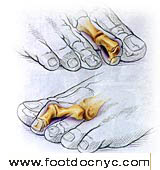 Mallet toes, hammer toes, and claw toes are most often caused by wearing shoes that are too short or heels that are too high. This jams the toes against the front of the shoe and causes one or more joints to bend. Rarely, disease can cause the joints in the toes to bend. Mallet, hammer, and claw toes are among the most common toe problems. They occur most often in the longest of the four smaller toes. Make an appointment with a NYC Podiatrist to discuss various treatments, both conservative and surgical for these conditions. Mallet toes, hammer toes, and claw toes are most often caused by wearing shoes that are too short or heels that are too high. This jams the toes against the front of the shoe and causes one or more joints to bend. Rarely, disease can cause the joints in the toes to bend. Mallet, hammer, and claw toes are among the most common toe problems. They occur most often in the longest of the four smaller toes. Make an appointment with a NYC Podiatrist to discuss various treatments, both conservative and surgical for these conditions.
Symptoms
You may feel pain in the toe or in the ball of your foot. A corn (a hard growth of skin on the top of the toe) may form where the toe rubs against the top of the shoe or a callus (a hard growth of skin on the bottom of the foot) may form under the tip of the toe or on the ball of the foot. Corns and calluses can also be painful.

BLACK-AND-BLUE NAILS
A black-and-blue nail is usually caused by sudden or repetitive injury to a toe. This might occur during sports or dance that involve running or stopping quickly, such as tennis or basketball. The injury may also result from a heavy object falling on a toe. Make an appointment with a NYC Podiatrist to start treatment for your black and blue nails.
Symptoms
The big toe is most often affected. Bruised, broken blood vessels cause the black-and-blue colors under the nail. If the condition is the result of a sudden injury, pain may be severe.

THICKENED NAILS
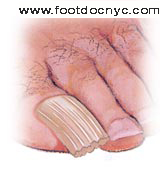 Abnormally thick or crumbling nails may be caused by injuries, pressure from shoes, fungal infections, or conditions such as diabetes, psoriasis, or vascular disease. Eventually, the nail may loosen and fall off. Make an appointment with a NYC Podiatrist to find out what you can do about thickened nails. Abnormally thick or crumbling nails may be caused by injuries, pressure from shoes, fungal infections, or conditions such as diabetes, psoriasis, or vascular disease. Eventually, the nail may loosen and fall off. Make an appointment with a NYC Podiatrist to find out what you can do about thickened nails.
Symptoms
Along with thickening, the nail may appear ridged, brittle, or yellowish. The nail may also feel painful when pressure is put on it.

|







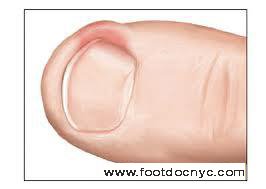






 Ankle sprains are the most common musculosceletal injuries seen by podiatrists. According to statistics, more than 20,000 people each day sprain their ankles. Ankle sprains can occur at anytime, whether its during sports or dance activity, or during regular daily activity, such as stepping your foot out of the car. Planting the foot wrong on the floor / ground can cause the ankle to roll to the side. This can stretch or tear ligaments. Once you've had an ankle sprain, you may be more likely to sprain that ankle again. Make an appointment with a NYC Podiatrist about treatment for your ankle sprain.
Ankle sprains are the most common musculosceletal injuries seen by podiatrists. According to statistics, more than 20,000 people each day sprain their ankles. Ankle sprains can occur at anytime, whether its during sports or dance activity, or during regular daily activity, such as stepping your foot out of the car. Planting the foot wrong on the floor / ground can cause the ankle to roll to the side. This can stretch or tear ligaments. Once you've had an ankle sprain, you may be more likely to sprain that ankle again. Make an appointment with a NYC Podiatrist about treatment for your ankle sprain. Ankle Sprain Symptoms
Ankle Sprain Symptoms A bunion is a deformity of the foot where the big toe turns toward the outside of the foot. Also, a bump forms on the inside of the foot where the big toe begins. This is caused from improper alignment of the bones in the foot with the ankle and leg as you walk. It is a genetic, developmental problem that usually begins at an early age. Make an appointment with a NYC Podiatrist about conservative and surgical treatments for bunions and hallux valgus.
A bunion is a deformity of the foot where the big toe turns toward the outside of the foot. Also, a bump forms on the inside of the foot where the big toe begins. This is caused from improper alignment of the bones in the foot with the ankle and leg as you walk. It is a genetic, developmental problem that usually begins at an early age. Make an appointment with a NYC Podiatrist about conservative and surgical treatments for bunions and hallux valgus. Wearing shoes with poor support and no cushioning can irritate the tissue in the foot known as the plantar fascia. Being overweight or standing for long periods of time can also irritate this tissue. Any sport or activity that puts stress on the foot can cause tears in the plantar fascia and even fractures in the heel bone. Make an appointment with a NYC Podiatrist to inquire about treatments for heel pain.
Wearing shoes with poor support and no cushioning can irritate the tissue in the foot known as the plantar fascia. Being overweight or standing for long periods of time can also irritate this tissue. Any sport or activity that puts stress on the foot can cause tears in the plantar fascia and even fractures in the heel bone. Make an appointment with a NYC Podiatrist to inquire about treatments for heel pain.
 Wearing tight or high-heeled shoes can cause a neuroma. Shoes that are too narrow or too pointed squeeze the bones in the ball of the foot. Shoes with high heels put extra pressure on the ends of the bones. When the bones are squeezed together, they pinch the nerve that runs between them. Make an appointment with a NYC Podiatrist to discuss neuroma treatments.
Wearing tight or high-heeled shoes can cause a neuroma. Shoes that are too narrow or too pointed squeeze the bones in the ball of the foot. Shoes with high heels put extra pressure on the ends of the bones. When the bones are squeezed together, they pinch the nerve that runs between them. Make an appointment with a NYC Podiatrist to discuss neuroma treatments.  The
plantar fascia is a ligament-like band running from your heel to the ball of
your foot. This band pulls on the heel bone, raising the arch of your foot as it
pushes off the ground. But if your foot moves incorrectly, the plantar fascia
may become strained. The fascia may swell and its tiny fibers may begin to fray,
causing plantar fasciitis. This can also be the beginning of a heel spur.
Make an appointment with a NYC Podiatrist to discuss
treatments for plantar fasciitis and having custom made orthotics
done for your feet.
The
plantar fascia is a ligament-like band running from your heel to the ball of
your foot. This band pulls on the heel bone, raising the arch of your foot as it
pushes off the ground. But if your foot moves incorrectly, the plantar fascia
may become strained. The fascia may swell and its tiny fibers may begin to fray,
causing plantar fasciitis. This can also be the beginning of a heel spur.
Make an appointment with a NYC Podiatrist to discuss
treatments for plantar fasciitis and having custom made orthotics
done for your feet. Mallet toes, hammer toes, and claw toes are most often caused by wearing shoes that are too short or heels that are too high. This jams the toes against the front of the shoe and causes one or more joints to bend. Rarely, disease can cause the joints in the toes to bend. Mallet, hammer, and claw toes are among the most common toe problems. They occur most often in the longest of the four smaller toes. Make an appointment with a NYC Podiatrist to discuss various treatments, both conservative and surgical for these conditions.
Mallet toes, hammer toes, and claw toes are most often caused by wearing shoes that are too short or heels that are too high. This jams the toes against the front of the shoe and causes one or more joints to bend. Rarely, disease can cause the joints in the toes to bend. Mallet, hammer, and claw toes are among the most common toe problems. They occur most often in the longest of the four smaller toes. Make an appointment with a NYC Podiatrist to discuss various treatments, both conservative and surgical for these conditions. Abnormally thick or crumbling nails may be caused by injuries, pressure from shoes, fungal infections, or conditions such as diabetes, psoriasis, or vascular disease. Eventually, the nail may loosen and fall off. Make an appointment with a NYC Podiatrist to find out what you can do about thickened nails.
Abnormally thick or crumbling nails may be caused by injuries, pressure from shoes, fungal infections, or conditions such as diabetes, psoriasis, or vascular disease. Eventually, the nail may loosen and fall off. Make an appointment with a NYC Podiatrist to find out what you can do about thickened nails.